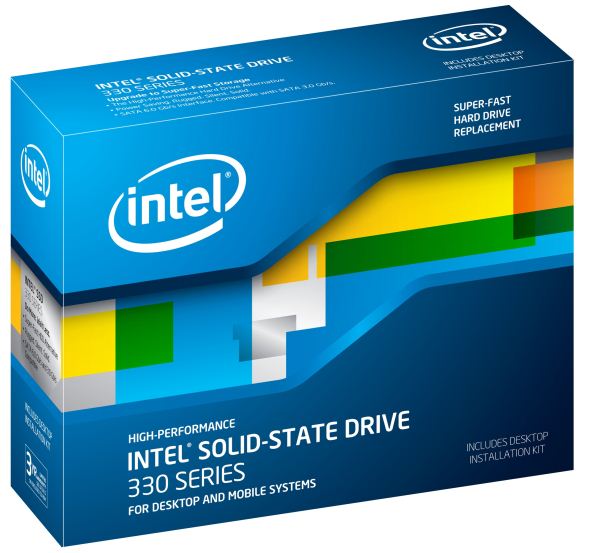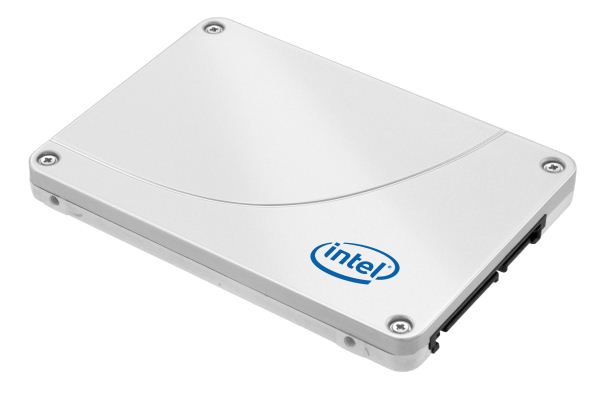Intel SSD 330 Officially Announced: Affordable SandForce
by Anand Lal Shimpi on April 16, 2012 11:00 AM ESTWe reported on Intel's SSD 330 weeks ago, but today is the official announcement of the drive and its availability in the channel. Unlike previous 300 series drives, the 330 isn't based on Intel's own controller - it's the second SandForce SF-2281 drive in Intel's lineup.
| Intel SSD Comparison | ||||||
| Intel SSD 520 | Intel SSD 510 | Intel SSD 330 | Intel SSD 320 | |||
| Capacity | 60 / 120 / 180 / 240 / 480GB | 120 / 250GB | 60 / 120 / 180GB | 40 / 80 / 120 / 160 / 300 / 600GB | ||
| Controller | SandForce SF-2281 | Marvell 9174 | SandForce SF-2281 | Intel X25-M G3 | ||
| Interface | 6Gbps SATA | 6Gbps SATA | 6Gbps SATA | 3Gbps SATA | ||
| Random Read Performance (Up to) | 50K IOPS | 20K IOPS | 42K IOPS | 39.5K IOPS | ||
| Random Write Performance (Up to) | 60K IOPS | 8K IOPS | 52K IOPS | 23K IOPS | ||
| Sequential Read Performance (Up to) | 550 MB/s | 500 MB/s | 500 MB/s | 270 MB/s | ||
| Sequential Write Performance (Up to) | 520 MB/s | 315 MB/s | 450 MB/s | 220 MB/s | ||
| Warranty | 5 years | 3 years | 3 years | 5 years | ||
The 330 differs from the SandForce based Intel SSD 520 in a couple of key areas. The 330 uses lower p/e count NAND (still Intel 25nm MLC) compared to the 520, reducing Intel's rated lifespan from 5 years of 20GB of writes per day to 3 years under the same workload. Intel's ratings have historically been conservative, so I'd expect that the 330 would last much longer than 3 years for the vast majority of workloads - particularly based on previous calculations on the topic. With a 3 year usable lifespan rating however, Intel dropped the limited warranty on the 330 to 3 years as well.
All of this results in a significant reduction in price compared to the 520:
| SSD Pricing Comparison | ||||||
| 60/64GB | 120GB/128GB | 180GB | ||||
| Crucial m4 | $79.99 | $154.99 | ||||
| Intel SSD 520 | $109.99 | $184.99 | $289.99 | |||
| Intel SSD 330 | $89 | $149 | $234 | |||
| Kingston HyperX 3K | $169.99 | |||||
| Samsung SSD 830 | $94.99 | $174.99 | ||||
| OCZ Vertex 3 | $98.99 | $159.99 | ||||
| OCZ Vertex 4 | $179.99 | |||||
In fact, the Intel SSD 330 appears to be the cheapest SF-2281 drive on the market today. Interestingly enough it's only available at three capacities (60, 120 & 180GB), while the Intel SSD 320 was available in far more models going all the way up to 600GB.
Performance ratings are down compared to the Intel SSD 520, although it's not clear whether these are artificial limits or not:
| Intel SSD 520 vs. 330 | ||||
| Intel SSD 520 120GB | Intel SSD 330 120GB | |||
| Capacity | 120GB | 120GB | ||
| Controller | SF-2281 | SF-2281 | ||
| Random Read Performance (Up to) | 25K IOPS | 22.5K IOPS | ||
| Random Write Performance (Up to) | 40K IOPS | 33K IOPS | ||
| Sequential Read Performance (Up to) | 550 MB/s | 500 MB/s | ||
| Sequential Write Performance (Up to) | 500 MB/s | 450 MB/s | ||
| Warranty | 5 years | 3 years | ||
| Price | $184 | $149 | ||
Presumably Intel's SSD 330 uses a similar custom firmware solution to the SSD 520, which should hopefully keep it safe from any SF-2281 related BSOD or other instability.
| Intel SSD 330 | |||||
| Capacity | 60GB | 120GB | 180GB | ||
| Controller | SandForce SF-2281 | SandForce SF-2281 | SandForce SF-2281 | ||
| Interface | 6Gbps SATA | 6Gbps SATA | 6Gbps SATA | ||
| Random Read Performance (Up to) | 12K IOPS | 22.5K IOPS | 42K IOPS | ||
| Random Write Performance (Up to) | 20.5K IOPS | 33K IOPS | 52K IOPS | ||
| Sequential Read Performance (Up to) | 500 MB/s | 500 MB/s | 500 MB/s | ||
| Sequential Write Performance (Up to) | 400 MB/s | 450 MB/s | 450 MB/s | ||
| Warranty | 3 years | 3 years | 3 years | ||
| MSRP | $89 | $149 | $234 | ||












75 Comments
View All Comments
jwilliams4200 - Tuesday, April 17, 2012 - link
I'm not sure why you find it hard to believe.Don't you know that the Intel 320 SSD has power-loss-protection capacitors for just the reason I described?
Also, Sandforce was touted from early days as supporting a supercapacitor for just this reason. But none of the consumer Sandforce SSDs actually use a supercapacitor.
bji - Tuesday, April 17, 2012 - link
To put it another way: "flush" is a simplified way of describing a complex process. "flushed" means "as persisted as the device is capable of making the data". "persisted" means "stored in such a manner as to be recoverable on a subsequent read".Clearly, not writing metadata to flash means that the data is not persisted, because it is not recoverable on a subsequent read.
Therefore, if the SSD is flushing only the user data, but not the LBA index or whatever other metadata, then it is not persisting the data, and it is lying if it says that it is.
If this is the case, I'd like to sue Intel for using Sandforce controllers because they are inherently defective. There is NO DIFFERENCE betwee this kind of lying about persistence, and intentionally writing garbage instead of the data that I had written. Or perhaps a better analogy would be, advertising a 100 GB drive as being 200 GB and just dropping any writes to the second 100 GB on the floor. It's defective, plain and simple; it does not satisfy the requirements of the interface that it claims to support.
seapeople - Tuesday, April 17, 2012 - link
You are a very strange dude.bji - Tuesday, April 17, 2012 - link
Well I was being facetious about suing Intel. But I am genuinely worried that SSD controller manufacturers may be playing games with data integrity for better performance numbers. Not sure what's strange about that.jwilliams4200 - Tuesday, April 17, 2012 - link
It seems strange to me that you seem to expect that SSDs behave in a certain way when it is clear that they do not actually behave in that way.bji - Tuesday, April 17, 2012 - link
It's not actually clear. Nobody can say for sure whether SSD controllers are properly persisting data + metadata on flush commands without rigorous testing.jwilliams4200 - Tuesday, April 17, 2012 - link
Ah, okay, in your world the 320 has power loss capacitors, and Sandforce supports supercapacitors, just for fun. No good reason. Right.You are a very strange dude.
bji - Tuesday, April 17, 2012 - link
I'll give you one more chance before concluding you're a troll just trying to annoy me.A device can use capacitors to increase performance by allowing writes to be cached in volatile storage even in the cases where the device has been instructed to flush the data to persistent storage. Because volatile memory + a capacitor with enough capacity to flush the volatile store to nonvolatile store is for all intents and purposes nonvolatile.
If a device DOES NOT have a capacitor or a spinning disk or whatever to provide enough energy to flush volatile storage, THEN it must implement other mechanisms to ensure that data is persisted.
IF such a drive DOES NOT have a capacitor, and DOES use write caching, and DOES NOT flush all data necessary to properly persist cached writes (including all metadata and the data itself), THEN it is lying when reporting that the data has been flushed to nonvolatile storage.
Just because some devices use capacitors doesn't mean that this is the ONLY WAY to guarantee persisted data.
Operating system filesystems cache write data too, you know. And they also supply a means for flushing cached writes out to permanent storage. But they don't *lie* for the purposes of making writes look faster - if you ask for the data to be flushed, the operating system will wait until it has been flushed.
The SSD should do the same thing. It should guarantee that the data is persisted when asked to do so - either by writing it to volatile RAM with enough stored energy to guarantee that it will be written out in the event of a power loss, OR by actually flushing it and all associated metadata necessary to recover the data.
The suggestion that some SSDs are simply lying when asked to flush write caches is worrisome; and nobody can say whether or not a particular controller is lying in this way without testing.
jwilliams4200 - Tuesday, April 17, 2012 - link
I stopped reading at your second paragraph.Why do you persist in imagining that SSDs work in some strange way other than they obviously do?
That is not what the capacitors are used for.
bji - Tuesday, April 17, 2012 - link
You haven't offered any evidence or theory to the contrary, and I don't think you have a clue.